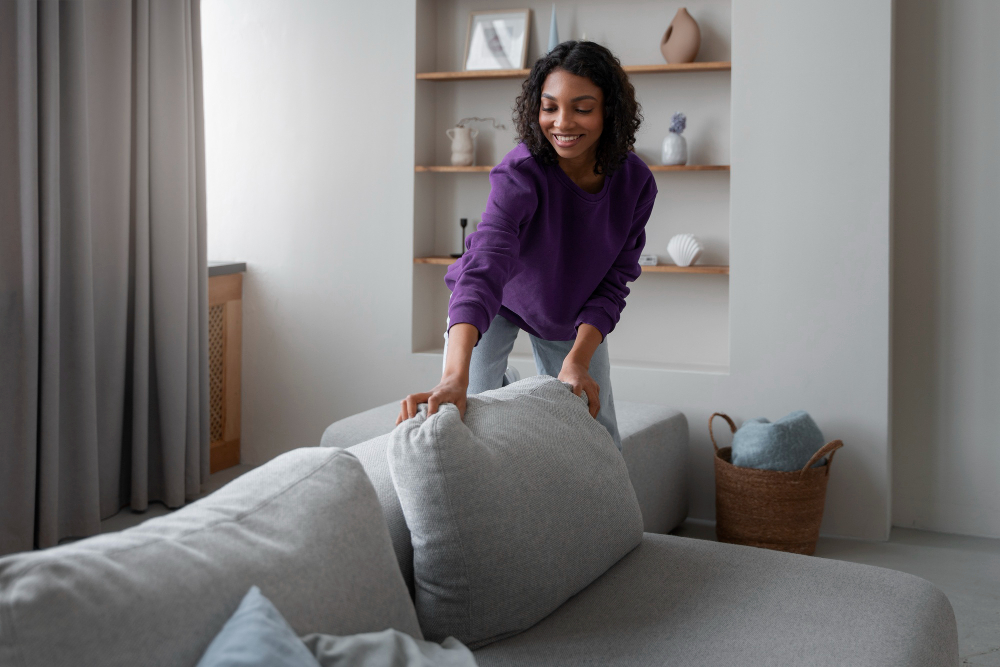Getting the keys to your first apartment in Canada is an exciting milestone until you walk into those empty rooms and realize just how much stuff you actually need. The excitement of independence quickly meets the reality of sticker shock when you start calculating what it costs to turn bare walls into a comfortable home.
Whether you’re a newcomer to Canada, a student starting university, or a young professional launching your career, you can create a comfortable, stylish home without emptying your bank account.
This guide will walk you through practical, affordable ways to furnish your apartment while keeping your budget intact and your style personal.
1. Start With the Essentials
Before you get excited about decorative pillows and artwork, focus on a handful of items that make the apartment livable. At the top of that list are a bed and mattress, a table or desk to eat and work at, a chair or two, basic kitchenware, and lighting. Those few things turn an empty box into a home.
Buy only what you need for now. A mattress, a table, a lamp, and a few plates will get you through the first month. You can add a sofa, rug, and art later. Staggering purchases keeps stress low and your bank account intact.
2. Set a Realistic Budget
Before you shop, make a simple plan. Decide how much you’re willing to spend in total and then break it down roughly by room. A practical split could be giving the largest share to your bedroom because good sleep matters, a modest portion for the kitchen so you can cook at home, and smaller amounts for the living area and bathroom.
Once you’ve mapped these costs out, it helps to know the kind of numbers you’re working with. On average, furnishing an apartment with brand-new items can cost between $3,500 and $5,800. If you’re looking for mid-range comfort with better quality and longevity, the figure often climbs to around $7,000 to $11,000.
That said, you don’t have to spend that much if everything doesn’t need to be brand new. With smart secondhand shopping, many newcomers furnish their first apartments for $2,000 to $5,000, or even less if they’re willing to hunt for deals.
3. Shop Secondhand First
Buying used is where you’ll save the most. Online marketplaces like Kijiji and Facebook Marketplace are full of solid finds if you learn how to search and inspect. Thrift stores and larger chains also receive donated furniture regularly, and is an excellent place to find hidden gems at a fraction of retail prices.
Thrift Store Options
- Value Village: Consistently good selection, regular sales
- Salvation Army: Part of one of Canada’s largest national charities and among the country’s largest clothing recyclers, offering significant savings through their thrift stores
- Goodwill: Smaller selection but often higher-quality items
- Local charity shops: Often the best deals with unique finds

Online Marketplaces
- Facebook Marketplace: Available in major cities like Calgary and Toronto, offering new and used furniture with local pickup options
- Kijiji: Canada’s leading classified platform where you can buy and sell new and used items locally, with dedicated furniture sections in major cities like Toronto GTA
- Craigslist: Less popular in Canada but still has listings in major cities
Tips for Quality Secondhand Shopping
- Inspect items carefully for structural integrity, not just appearance
- Test drawers, doors, and moving parts
- Check for bedbugs or signs of pest damage on upholstered items
- Negotiate prices, especially when buying multiple items
- Bring a measuring tape and know your space dimensions
- Have transportation arranged before you buy
University and Community Resources
- Check university housing boards during move-out seasons (April-May, August-September)
- Join local community Facebook groups where people give away or sell items cheaply
- Look for international student groups where departing students sell furniture
4. Explore Affordable Retail Options
When you do buy new, know where to look. Big box and online stores in Canada offer affordable, functional pieces that are easy to assemble and replace. Stores that frequently come up as reliable low-cost options include IKEA, Costco, The Brick, Wayfair, Structube, Walmart, Overstock.com and Canadian Tire. These retailers often run seasonal sales and clearance events that can save you a lot when timed right.
Before you buy new, compare the same item across two or three stores and check for free shipping or in-store pickup. For basics like flatware, sheets, and shower curtains, superstores and dollar or discount shops are perfectly fine choices.
Money-Saving Strategies
- Sign up for store newsletters to get sale notifications
- Shop end-of-season clearances
- Check for student discounts (many stores offer 10-15% off)
- Consider store credit cards for additional discounts if you can pay them off immediately
- Take advantage of IKEA Family membership for exclusive discounts, including 20% off dining room furniture
5. Mix and Match New With Used
Some items are worth buying new, and a mattress is at the top of that list. Because of long-term health, allergens, and hygiene, it’s better to invest in one you can trust. Bed frames, small kitchen appliances, and anything that touches food or skin also fall into the “buy new” category.
On the other hand, tables, bookshelves, dressers, and many types of chairs are usually safe to buy used as long as you inspect them carefully. If you come across a used mattress that looks like the perfect deal, think twice. Only go ahead if you can confirm its history and arrange for professional cleaning. Experts also warn about chemical treatments and other hidden issues in old mattresses, so it’s best to factor that risk into your decision.
A simple way to strike a balance is the 70/30 rule: spend about 70% of your furniture budget on used items and 30% on new essentials. This approach helps you stretch your budget while still ensuring quality where it matters most.
In the end, furnishing wisely is about knowing what to prioritize new and what you can confidently buy secondhand.
6. Try DIY and Upcycling
A little paint or new hardware can make a thrifted dresser feel custom and modern. Contact paper changes the look of an old table. New cushions and covers breathe life into a secondhand chair.
DIY projects not only save money but also give your space character. There are plenty of beginner-friendly tutorials online for painting furniture, assembling shelves, and small upholstery updates.
7. Look for Multi-Purpose Furniture
In Canadian apartments, especially in pricier cities like Toronto and Vancouver, space is often limited. Choosing multi-purpose furniture maximizes both your space and budget. These pieces reduce the number of items you need to buy and make moving easier when it’s time to relocate.
Here are some smart options to consider:
- Storage ottomans: triple duty as seating, a footrest, and hidden storage.
- Futons or sofa beds: comfortable seating that easily converts into a guest bed.
- Dining tables with storage: built-in drawers or shelves for kitchen essentials.
- Nesting tables: several surface options that tuck neatly together when not in use.
- Folding furniture: chairs and tables that store away compactly.

8. Take Advantage of Freebies
One of the underrated perks of living in Canada is the culture of giving away usable items, especially in cities and university towns. If you know where to look, you can furnish parts of your apartment without spending a dime.
Some of the best spots include curbside finds in wealthier neighborhoods on garbage day, Facebook “Buy Nothing” groups active in most Canadian cities, and university areas where students clear out their apartments at the end of the semester. Kijiji’s free section is also a goldmine, with people eager to pass on items quickly.
That said, safety should always come first. Free doesn’t mean careless. Avoid upholstered items unless you’re absolutely sure of their cleanliness, and inspect everything for structural damage or hidden issues. Bring a friend to help with heavy lifting, and clean every item thoroughly before moving it into your home.
9. Plan Room by Room
Furnishing your entire apartment at once is expensive and overwhelming. A room-by-room approach helps you budget better and make thoughtful choices.
Recommended Furnishing Order
- Bedroom first: You need somewhere to sleep immediately
- Kitchen basics: Essential cookware and dishes for daily meals
- Living room: Seating for relaxing and guests
- Dining area: Can often double-duty with living room furniture initially
- Decorative touches: Save these for last when essentials are covered
Even with a room-by-room strategy, coziness doesn’t have to wait. Affordable lighting, like floor or table lamps, often creates a warmer atmosphere than overhead fixtures. Throws, cushions, and rugs can transform a space quickly without draining your wallet, while plants are a low-cost way to add color and life. For walls, inexpensive prints, local artwork, or even downloadable designs can make a big difference.
When it comes to decorating without overspending, get creative with what you already have. Books, personal items, or even postcards and maps can double as décor when framed. A trip to Dollarama can also surprise you with affordable accents. Sometimes, grouping similar items together creates more visual impact than buying new pieces.
Common Mistakes to Avoid
- Don’t Buy Everything New Immediately: The temptation to have a complete space right away leads to expensive impulse purchases. Take time to find deals and make thoughtful choices.
- Don’t Ignore Quality for Price: A $50 chair that breaks in three months costs more than a $150 chair that lasts five years. Balance immediate budget constraints with long-term value.
- Don’t Overspend on Decor Before Essentials:It’s tempting to buy cute decorative items, but make sure you can sleep, sit, and eat comfortably before you worry about throw pillows.
- Don’t Shop Without Measurements: Nothing is more frustrating than finding the perfect piece only to discover it doesn’t fit your space. Always know your dimensions.
- Don’t Ignore Assembly Requirements: Unless you’re living in a furnished home or having used furniture delivered, newly purchased furniture will likely arrive as pieces in a box requiring assembly. Factor in your time and ability, or budget for assembly services.
- Don’t Forget About Moving Costs: Consider whether you’ll want to take furniture with you when you move. Expensive, heavy pieces might not be worth it if you’re likely to relocate.
A Furnishing Budget Example
To give you a clearer picture, here’s how a newcomer in Canada might furnish a one-bedroom apartment for under $2,500.
Bedroom ($800)
- mattress and box spring from Walmart: $200
- IKEA bed frame: $150
- Used dresser (refinished with $20 paint): $100
- New pillows and sheets: $80
- Basic lamp from Walmart: $25
- Mirror from thrift store: $15
Living Room ($600)
- Used loveseat from Kijiji: $200
- Coffee table from Value Village: $30
- Floor lamp from Canadian Tire sale: $40
- Throw pillows and blanket from Dollarama: $30
- Small side table (DIY from crates): $25
- Basic TV stand from IKEA: $50
Kitchen/Dining ($400)
- Small table and two chairs from thrift store: $100
- Basic cookware set from Walmart: $80
- Dishes and glasses from Value Village: $40
- Kitchen utensils and basics: $60
- Small appliances (used): $120
Miscellaneous ($300)
- Curtains from Walmart: $80
- Cleaning supplies: $50
- Basic tools for assembly: $40
- Laundry basket and hangers: $30
- Plants and small decor items: $100
Total: $2,100
With this budget, you’ve got all the essentials covered while still leaving a few hundred dollars for unexpected finds or higher-priority upgrades.
Your Furnished Future
Furnishing your first apartment in Canada on a budget is about being resourceful, creative, and intentional about creating a space that feels like home. The mix of secondhand treasures, smart new purchases, and DIY projects often results in a more interesting, personal space than buying everything new from one store.
Remember that your first apartment is exactly that – your first. It doesn’t need to look like magazine-worthy immediately. Take time to understand how you live in your space, what you actually use, and what brings you joy. The best-furnished apartments tell a story about the people who live there, combining practical needs with personal style.
Note: This guide provides general information about furnishing apartments in Canada. Prices and availability may vary by location and season.












